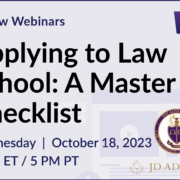Three LSAT Logical Reasoning Tips
Three LSAT Logical Reasoning Tips
The LSAT Logical Reasoning sections contain more than half of the points available on the test. Suffice to say, it is important to make sure you are as ready as possible to tackle these questions. In this post, we cover LSAT Logical Reasoning tips to help you succeed on test day!
Three LSAT Logical Reasoning Tips
1. Know your weaknesses, and adjust for them on test day.
The first of our LSAT Logical Reasoning tips is to know your weaknesses and adjust for them on test day. It is not uncommon for students to struggle with one particular question type. Often, these questions make or break an LSAT Logical Reasoning section, even if there are only two or three of them. Students let themselves get caught up on these questions, and then either doubt themselves the rest of the section because of their struggles or don’t finish in time. It’s vital to know what your weaknesses are so you can adjust to them for test day.
How exactly can you adjust for them? There’s nothing in the LSAT instructions that say you have to go in a specific order within a section. So, if you know you struggle with assumption questions, it may be best to save those until last. That way, you see all the other questions in that section first. A great way to implement this strategy is to read the question first. That way, you don’t waste time reading the passage, and then get to the question only to realize you should save it for last. This approach is a huge timesaver for many students and allows them to save difficult-for-them questions until the end. That way, they are much less likely to run out of time or doubt themselves on other question types.
2. Pay attention to keywords, and narrow the scope of answers when possible.
The next of our LSAT Logical Reasoning Tips is to scrutinize answers as much as possible. Students who struggle with the Logical Reasoning sections on the LSAT often find themselves down to two answers, and “always” manage to pick the wrong one. In many ways, this is by design. The LSAT test not only your ability to process information quickly, and then apply it to a particular situation. It also makes sure that you apply the information you use correctly. The distinction is important: you can have an excellent grasp on the material in a particular question, but if you draw too broad of a conclusion from it, you’ll inevitably get questions wrong.
Often, LSAC will include an answer that seems almost right but manages to confuse terms. So, as much as possible, try to narrow the scope of answers. Let’s say a sample problem gives you information on a certain species of bear and asks you to draw a conclusion. If you are down to two answers that seem plausible, make sure they both address the same subject. Often, you’ll find answers that are too broad. In this instance, it would draw a conclusion about all bears. A more tailored answer about the specific bear species is generally more on point.
So, make sure that, from start to finish, the information in any particular question stays on the same point. Make sure to note what specific topic you are focusing on, and highlight any change in terms. These are often the easiest way to crack a tricky Logical Reasoning problem.
3. Practice timing
The last of our LSAT Logical Reasoning tips is to practice timing. Timing is a crucial component of the LSAT. The Logical Reasoning section is no different. In some ways, it may be the most difficult portion to finish in the allotted time. Students generally are daunted by the size of the Reading Comprehension passages. However, instead of four longer passages, the Logical Reasoning section asks you to cover 51 smaller, less detailed scenarios. If you get caught up in one or two of them and lose track of time, you run the risk of having a timing issue later in that section.
So, during your preparation, make timing a key part of your studies. After you learn the basics of approaching Logical Reasoning questions, implement a timer as soon as possible. You can start small, for example, and make sure you can finish five in a prorated amount of time. Then, build your way up to ten questions, then fifteen, and so on. By test day, you should be comfortable working under the time restrictions, and know when you take too long on any one particular problem.
NICK, OUR LSAT TUTOR, WROTE THIS POST. NICK SCORED IN ONE OF THE TOP PERCENTILES ON THE LSAT AND ENJOYS HELPING STUDENTS ACHIEVE THEIR DREAM SCORES AND GET INTO THEIR DREAM SCHOOLS!
Pursuing Law School? We’ve Got You Covered!
🌟 Special Offer: Enroll in our FREE on-demand law school prep course, meticulously crafted by a top-ranked law student. Secure your spot now






Leave a Reply
Want to join the discussion?Feel free to contribute!